things to have at the telescope
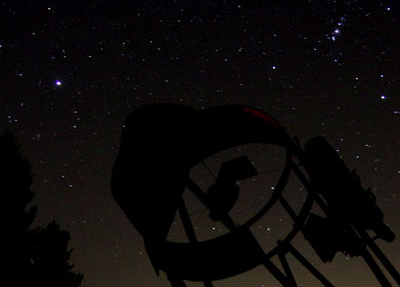
|
things to have at the telescope
|
|
hardware
|
Chair I like to sit at the telescope, even at my 22-Inch Dob. Therefore I made an observing chair, which can be very easily adjusted from very low to very high. You just need to lift the board of the seat and move it up or down. Find more about this chair here.
|
|
Table I need a lot of stuff for observing, eyepieces, star maps, guide books, etc. That's why I need a table. This is a very simple camping table in which I drilled 1.25 and 2 inch holes to store the eyepieces.
|
|
|
Red Flashlight A good (!) red flashlight is essential. A "good" one should have really deep red light >630 nm (not light red!) and its brightness should be adjustable from very dim for reading the star map to very bright for setting up the telescope. More about red light and dark adaptation is here. I used a deep red LED (650 nm), which is operated with a 9V battery, protected by a 350 Ohm resistor and adjusted by a 10 kOhm linear trimmer. Additionally I have a red headlamp, in which I put a super bright red LED (2xAA, 3V, 45 Ohm resistor.) |
|
|
Stray light Cloth Only
under a piece of cloth you are completely protected from stray light. This
is essential when you are hunting for the faintest galaxies, nebula or
planetaries. My stray light cloth is shaped as a hood. The others say it
looks really silly, but, well, I use it only in the dark ...
|
|
|
There are many myths about collimating a Newtonian. In fact, collimation is neither complicated nor time consuming, if you have understood its basics. Complete collimation of the telescope (focuser, secondary, and primary) is required in general only once, before you use the telescope for the first time. A daily collimation is required only for the primary. Even with my 22" Dob, this takes only a minute. For collimation, I use a very simple device, consisting of a semitransparent tube with a central peep hole in the lid, similar to the Cheshire tools that are offered commercially. Alternatively, an empty film container (for those who still remember what this is in our digital age) with a peep hole will do as well. Laser collimators can be useful for collimating the secondary, which is done once and which can be done as well with Cheshire or film container tool. For daily collimation of the primary, a laser is disadvantageous and can even ruin your collimation entirely!!! In contrast to a laser, sight tubes are "self centering" as your eye will be looking automatically in the right direction, toward the primary's center spot. This allows precise collimation of the primary, even if the secondary's collimation is *not* absolutely pin point (which, unlike precise collimation of the primary, is not a pre-requirement for good optical performance of the telescope). Read on here. |
|
|
Finders I generally use two finders, a red dot finder and an optical finder. In my smaller Dobs, I use as an optical finder a half of 10x50 binoculars, in which I put crosshairs. I like a straight finder with no image inversion or whatsoever. In my large Dob, I have an 80 mm finder equipped with an Amici prism, giving an upright image, yet with a 90° angle. With a supplementary UHC filter, this finder also serves as an additional small telescope for the large extended HII regions. |
|
To prevent dew on both the red dot and the optical finder, I have mounted simple extensions to their dew shields that are laminated on the outside with metal foil. This efficiently prevents any fogging of the optics. |
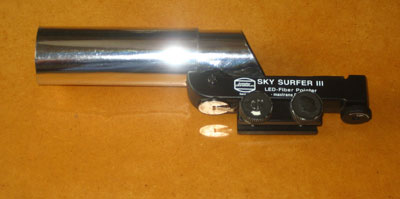 |
|
I changed my eyepiece palette in 2014/2015 to a 100° series, the TS XWA series. With three of these eyepieces, I cover except for highest magnifications most of my observing. The TS XWA 20mm is my finder eyepiece, the TS XWA 9mm is for an intermediate exit pupil, and the TS XWA 5mm is for all these tiny objects and planets. II am very satisfied with the optical performance of these eyepieces. In combination with a Paracorr, even the XWA 20 is sharp to the edge using my f/4 Dob. This is not a mean achievement for such a huge field. The other two eyepieces are equally well designed. What I still need to get used to is the large eyecup in particular of the XWA 20. The TS XWA eyepiece series is identical to the Skywatcher Myriad series and the William Optics XWA series. Likely identical except for the different eyecup is the Lunt HDC series. What I dislike is the fact, that the series is NOT parfocal in 2" mode using the sleeves that accompany the eyepieces. If you use a coma corrector, this is more than bothering. The XWA 20 needs much more intrafocal path than the other eyepieces. If you use the shorter focal length XWAs in 1.25" mode, the eyepieces get closer to being parfocal, but it is still not perfect. Therefore, I removed the 2" sleeves of the XWA 9 and 5 and replaced it with custom-fit 2" to 1.25" reducers that are permanently installed at each eyepiece and are adjusted for perfect parfocality. For the rehabilitation of the XWAs it has to be mentioned, that even Televue did not succeed to make their Ethos (and to some extent even their Delos) line completely parfocal, despite that these eyepieces are in an entirely different price class.
|
|
|
My previous eyepiece set consisted of a 24mm Panoptic for 5.3mm exit pupil, a 13mm T6 Nagler for about 3mm exit pupil, a 7mm T6 for 1.5mm exit pupil, and a 5mm T6 for slightly above 1mm exit pupil (all for f/4.6 ). I intend to use this series with my travel telescopes. For maximal exit pupil (7mm) and usually combined with filters only, I use a budget-priced 32 mm Erfle (TS-SW). This eyepiece suffers considerably from the fast optics of my Dobs, but this is far less dramatic than one would expect when combined with averted vision and narrowband filters. For PuWe 1, Sharpless 129, or the Eridanus Loop, such an eyepiece is more than sufficient.
|
|
|
With my f/4.0 Dob, I use the Paracorr I by Televue, which remains permanently in the focuser. For this reason, my eyepieces (except for the Planetary) are homofocal, such that the Paracorr remains at one single setting. The focal ratio of my Dob is extended by the Paracorr to f/4.6, which considerably improves the performance of my long focal length eyepieces, the 32 mm Erfle and the 24mm Panoptic. |
|
|
For starters, the Skywatcher UWA
eyepieces (exist also under other labels) are recommended, which are
available as 6, 9, 15 und 20mm with a 67° apparent field of view. They
cost about 35€ and are, except for the 20mm, still quite useful down to
f/5 and allow for a very relaxed viewing.
For the shorter focal lengths, the TMB Planetaries (again available under different labels for down to 40€) can be recommended, which work fine down to f/4. They do, however, sometimes require some amending regarding the stray light suppression. A small aperture stop of black cardboard after the barlow element helps a lot. |
|
| For difficult targets near bright other objects, such as Sirius B, the moons of Uranus, or Barnard's Nebula next to Merope, I have prepared a 5mm eyepiece with an occulting bar placed at the field stop. This allows keeping the bright object behind the bar and reducing its compromising glare. |
|
|
My entire equipment fits in a pilot's
case, where everything is stowed well arranged and still compact.
At the telescope, the most used eyepieces fit in a waist bag. During cold or humid weather, this bag can be carried under the jacket to shield the optics from freezing or dew. |
|
|
All my Deep Sky observing is done monocular, as even for the brighter Deep Sky objects the transmission losses are considerable. However for the sun (white light) and in particular the moon, I like to use a binoviewer. I use a modified microscope binoviewer that uses only mirrors (except for the beamsplitter). I equipped it with two Skywatcher 15mm eyepieces and change magnification by using a barlow element with different optional extensions (2x to 5x) and a homemade telecentric system (1.3x). You won't see more with a binoviewer, but you will see it more comfortably and more pleasing, in particular if you observe the moon. By viewing with both eyes, our brain does a much better job in filtering out the low-frequency and large-scale image motion than monocular. This makes for much more relaxed viewing. Another positive effect is the subjective increase of the apparent field of view as compared with monocular observing. With my 8" Dob and much more with my 14" Dob (my equatorially mounted main telescopes for the moon), the seeing is in most cases limiting and not the quality of the optical train. Imperfections introduced by the binoviewer are therefore normally not noticeable. For those moments of perfect seeing where you can go to the limit of your optics, I also switch to monocular observing.
|
|
|
Filters and Filter Slide I routinely make a lot of use of narrow band and line filters (UHC, OIII, and H beta). It is a nice thing to have a filter slide for them. You can quickly switch between the different filters and the unfiltered view without taking out the eyepiece. Very convenient!
|
|
| To avoid dew on the filters, I made a cover of aluminum that can be attached to the fixed part of the filter slide and covers the filters from one side. This prevents efficiently formation of dew on the filters. |
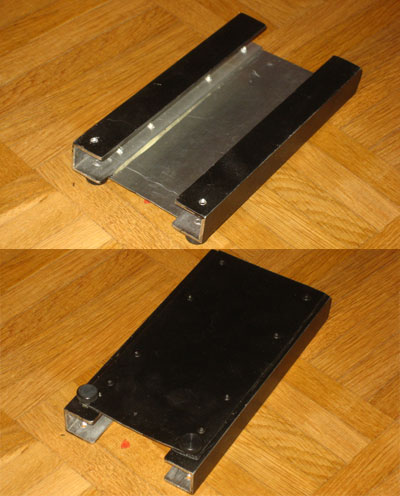 |
|
The
filters
that I use are a Lumicon OIII filter, a Lumicon H-beta filter
and an Astronomik UHC filter, all in 2" format, which have their
place in the filter slide. In principle, I would keep an eye on keeping
your filters homofocal, i.e. with identical thickness of the substrate,
and choose filters from a single manufacturer. My choice would clearly be
Lumicon. Transmission spectra of my narrowband filters are
here. I further have: - a 2" OIII by Baader, which is in particular with fainter OIII objects clearly inferior to the Lumicon OIII and considerably cuts the fainter of the OIII lines at 496nm. - a 1.25" Lumicon H-beta and, in the same size, an Astronomik UHC filter for my 80mm finder (which becomes then the ideal Richfielder for the extremely large and faint Sharpless objects). - a 2" polarizing filter for observing polarization in reflection or synchrotron nebula. I don't use gray or color filters. |
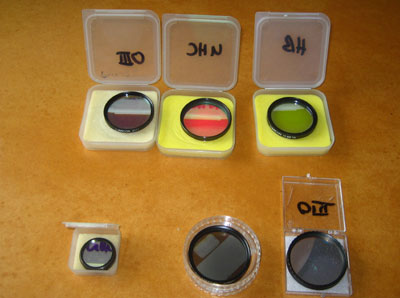 |
|
Binoculars Every once in a while, I also observe with my 15x70mm Skymaster binoculars by Celestron, that are available also under other labels for around 80-120€. These binoculars are very light-weight and can be used as well without a tripod. This is quite important to me, as I like to use my binoculars when lying on the ground with the eyepiece cups sitting on my eyebrows. |
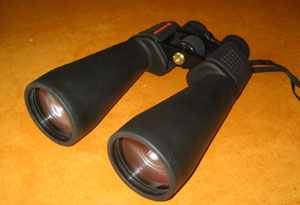 |
|
Binoculars and Filter Many of the large HII regions such as the California Nebula, the Gamma-Cygni-Nebula, Barnard's Loop or the Heart and Soul are actually too large for "real" telescopes. 2" filters fit perfectly into the lens mount of 7x50 binoculars and can be retained there be cut-out lens caps. |
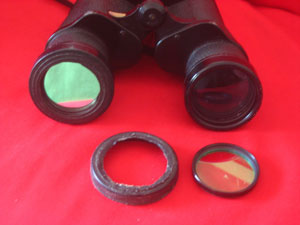 |
|
EQ Platform If you have ever observed with a platform you won't want to go without one any more. An EQ platform maintains the intuitive handling of a Dobsonian telescope but adds the automatic tracking. More about platforms can be found here. |
I am quite picky about star maps and use almost exclusively maps of Wil Tirion. It is small details that render a map clear and concise and that allow to find quickly suitable patterns for star hopping. I mostly use the Sky Atlas 2000 for regular work at the telescope and printouts prepared with Carted du Ciel for everything beyond the Star Atlas. The Uranometria is only rarely used due to its format as a book and the small field sizes.
Detailed charts for more difficult objects are prepared with the free charting software Cartes du Ciel (Sky Charts). For getting a quick overview of some brighter objects, I often use the Cambridge Star Atlas, which is a nice star atlas especially for beginners and gets a lot of use for observing from my backyard with my 8".
| The Cambridge Star Atlas (30 Euro, Cambridge University Press), Hardcover with 20 charts and limiting magnitude of 6.5. There is a star chart on one page and information on the deep sky objects on the opposing page. Nice combination of star atlas and guide book. I use it (despite observing with a 22-Inch telescope) for instance for getting an overview of this No Man's Land between Pisces, Aquarius, and Capricorn ... |
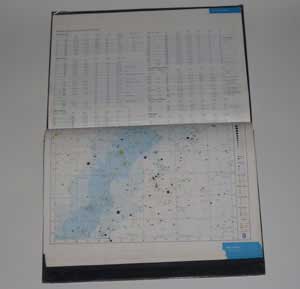 |
|
Sky Atlas 2000 (2nd ed., 32 Euro, Sky Publishing), 29 charts with limiting magnitude 8.5. Great Atlas, but too large format for use at the eyepiece. I therefore photocopied this atlas, one page on two DIN A4 pages and put them into transparent sheet protectors in a ring binder. Now I can take out the page that I need for use at the telescope. I consider the Desk-version to be better, as you can more easily copy it (the deLuxe version has red galaxies that turn black when copied), and you can add additional objects on the maps, which is possibly only with a white background. The Sky Atlas is the atlas I use by far the most. |
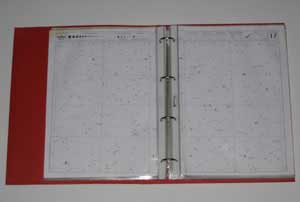 |
|
Uranometria (2nd ed., two volumes each 60 Euro, Willmann-Bell), Hardcover with more than 200 charts with limiting magnitude 9.75. Very detailed charts, where you get easily lost. I have this atlas but hardly use it anymore, in particular not at the telescope. |
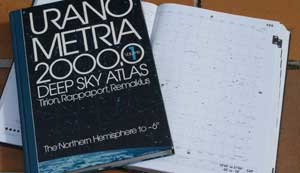 |
|
Cartes du Ciel (Sky Charts), Freeware charting program by Patrick Chevalley, highly recommended! Excellent for preparing finder charts (see all my atlases in the Observing section) Additional catalogs by Oleg Malyi are available here I have compiled the following catalogs Abell: Abell PN HCG: Hickson Compact Groups of Galaxies vdB: van den Bergh Reflection Nebula Sh2: Sharpless Emission Nebula Copy the catalog files into the program folder "ciel/cat/" and add and activate the catalog in the menu. |
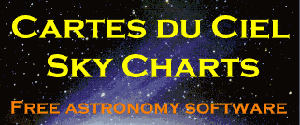 |
|
I personally like to use observing guides that combine images and data with finder charts of deep sky objects. I have put together my own material for these purposes, which is partly available for download here as pdf files. This is what I use at the telescope, together with my edited version of the Sky Atlas 2000. |
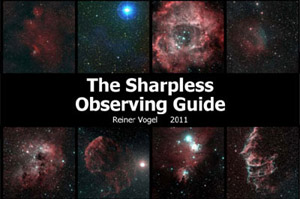
|
|
There are many nice websites, which are useful for deep sky observers. but there is one that I like the most, the "Adventures in Deep Space" by Steve Gottlieb, Jim Shields, and Mark Wagner. In the tab "much more" there is in addition a very interesting collection of articles from other observers. Check it out!
|
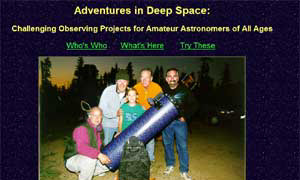 |
|
pdf guidebooks are available from Alvin Huey about Local Group galaxies, galaxy groups, Abell clusters, and many more. Besides these, Alvin also offers "real" Observing Guides for Hicksons, Abell PNs and Arp Galaxies. Very interesting as well is this compilation of interesting observing lists by Paul Alsing here. Particularly interesting is this pdf guide here (30MB). |
| The classical observing guide book is the Night
Sky Observers Guide (2
volumes, each around 40 Euro, Willmann-Bell) by George Kepple and Glen
Sanner. This is for every serious telescope aperture, but might be to
obverwhelming for beginners. Those might rather opt for Ronald Stoyan's Deep
Sky Reiseführer (Oculum
Verlag, 40 Euro, in German).
I personally did use these guidebooks a lot when I started my observing many years ago. In the meantime, I have replaced these books by my own material (see above). |
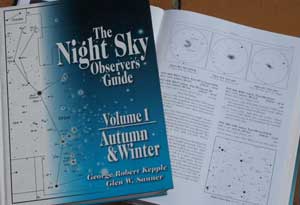 |
... and the moon ...
|
... I have
to make a confession: Despite being mostly a Deep Sky observer, in between New
Moon phases I also get friend with the moon, this night sky polluter.
I started getting deeper into Moon observing initially with our club's Celestron 14 and now use regularly my 14" Dob on EQ platform, equipped with binoviewer and widefield eyepieces. That's true Apollo feeling! For observing the moon, I use besides the Rükl Moon Atlas also my laptop computer and the Virtual Moon Atlas by Patrick Chevalley and Christian Legrand. Very nice interactive features with links to pictures and information. More about the free ware software can be found here.
|
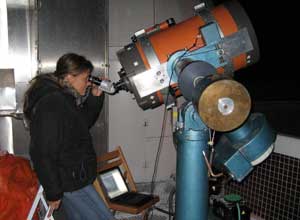 |
|
Additionally, I have the NASA Lunar Astronautical Charts (LAC) on my computer, which are great lunar maps. Can be ordered as excellent laminated A3 printouts in Peter Grego's online store.
|
|
|
Those who want to know more about the moon
and what to observe should get Charles Wood's The Modern Moon - A
personal view. Wood, a former professional moon researcher, is author of
the Sky and Telescope monthly moon column and has initiated the Moon Wiki.
The more you know about the moon, the more interesting the observing sessions become. It's the same with the moon as with many other things. |
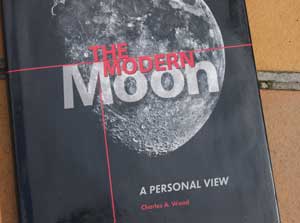 |
|
A good companion to this book is Wood's excellent 21st Century Atlas of the Moon, a photographic atlas of the moon based on images taken by the LROC probe. This atlas has mostly replaced my Rückl with its small charts and its very detailed, yet somewhat confusing presentation of the surface features. |
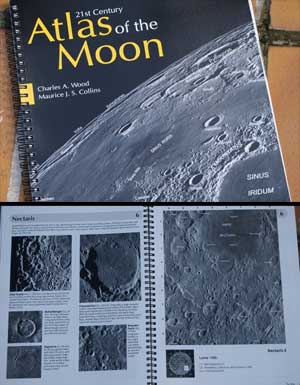 |
![]()